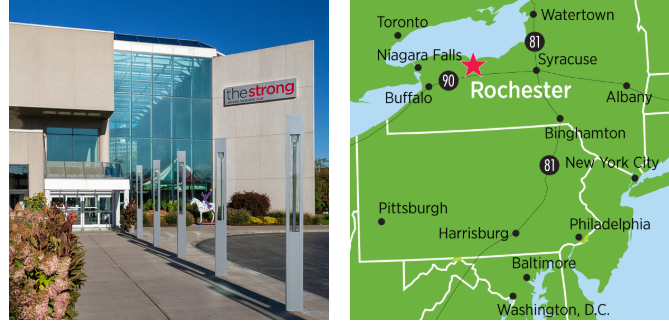
The following Six Questions with Shane Rhinewald shares some of the many treasures found at The Strong Museum of Play. I visited there about a year ago and it is an amazing and interactive place. The museum offers so much fun for both the young and old with its creative exhibits. They let you experience and explore (and remember) the world of Play!
Plus, in a final bonus question, Shane mentions some ‘lost treasures’ the Museum would love to find! Might you be able to help them find a lost treasure- that belongs in a Museum! Have fun!

Six Questions with Shane:
- 1Q) When did you start working for the Strong Museum. Can you share some of its history and where it is at?
The Strong National Museum of Play in Rochester, New York, is the only museum in the world dedicated to the study and history of play. It blends the elements of interactive, family museums with elements of a history museum. The museum houses more than half a million objects of play—toys, dolls, board games, video games, and other materials. (It is a wonderland of play!)
Margaret Woodbury Strong, the museum’s founder, was a wealthy woman from the Rochester area who traveled the world as a child in the early 1900s and fell in love with collecting, particularly dolls, toys, and miniatures. She intended to create a formal museum but died in 1969. She left behind the bulk of her wealth and collections to realize this dream, though, and The Strong opened in 1982. Since then, it has undergone numerous changes—including moving to its play-based mission in 2003 and a major expansion in 2006—that have helped it to become a national destination. The museum also houses two hall of fame programs for toys and video games, a center dedicated to preserving the history of electronic games, an early-education school, an academic and public library, and it publishes a peer-reviewed journal about play.
I started working at The Strong in 2008, and I have had the pleasure of telling the many, many amazing stories about the museum—from new exhibitions and collections items, to public programs and hall of fame inductees. I get to “play” in the world’s biggest toybox each day.
- 2Q) What do you enjoy most about working at the museum?
The museum represents learning, dreaming, discovery, and joy. Play is universal, and it is something that binds us all. We all have shared memories of how we played as children and continue to play now. I love the magic of play and how the museum inspires people. I particularly enjoy touring people through the museum and seeing their faces light with excitement after discovering a favorite toy from the past.

- 3Q) Do you feel there is one exhibit or artifact that the museum is most known for? Can you share some interesting facts about it?
The museum is home to the National Toy Hall of Fame and houses an exhibit dedicated to that program that features examples of all the inducted toys—from LEGO and Hot Wheels, to nontraditional toys like the cardboard box and the stick. It offers a meaningful trip down memory lane. The exhibit also features unique motion-capture interactives that allow you to play with the toys in new ways. For example, there’s a virtual bubble toy where you can make and manipulate bubbles (a hall of fame inductee) without making a mess!
- 4Q) Is there some often forgotten item that shouldn’t be missed when visiting?
The museum houses one of Thomas Edison’s talking dolls, which is a fun oddity. Among the many things that Edison invented, he is probably least known for making the first doll that spoke. Why? Because it was a huge, commercial flop. He created it around 1890 and released it before the holiday season. While the technology was advanced for the age, it was still primitive. The dolls emitted voices that sound like something out of a horror movie! You can hear a recording of the voice at The Strong, and that experience is not to be missed!
- 5Q) What do you feel is the most valuable ‘treasure’ of the museum? It might not be a monetary value, but of a historical value or even sentimental?
The museum holds the first Monopoly set created by Charles Darrow, who popularized the game and sold it to Parker Brothers. It is the original Monopoly as we know it, but Darrow based the game on another game—the Landlords Game—created by Elizabeth Magie. Unfortunately, Magie was largely written out of history, and Darrow went from being unemployed during the Great Depression to a board game titan. In some ways, the artifact tells a rags to riches success story of the American dream during the 1930s, but when you dig a bit deeper, it also tells a sadder story about a woman not receiving her proper due. It’s more than an old board game—it is a fascinating look into the 1930s and it sparks deeper conversations about capitalism, copyright, gender, and more.
- 6Q) Is there any advice you would have for those wanting to visit? Are there best times of the day, or days of the week to come? How long should visitors allow on their schedules to explore the fascinating exhibits? Anything else?
As of this writing, the museum just reopened after a nearly four-month closure due to the COVID-19 pandemic. This has been an unprecedented time. The museum put in place new safety protocols, timed-sessions, and capacity limits. Anyone looking to visit in the near term should visit https://www.museumofplay.org/play-safe
- Bonus Question! Is there an item, a lost treasure so to speak, that the Museum is on the lookout for? Might it be out there to find?
The museum is always on the lookout for prototypes and precursors to popular toys and games. Those help us tell the story of how some of these cultural icons came into being. As for one specific artifact—I often hear our curators talking about Monopoly board games that intelligence agencies used during World War II to smuggle maps and other materials to Allied prisoners of war. I don’t know if any of those games still exist, but that’s the kind of artifact with a story to tell!


